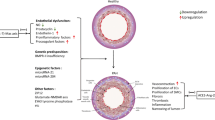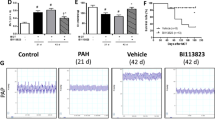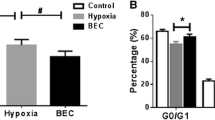Abstract
Background
Angiotensin-converting enzyme 2 (ACE2), an ACE homolog, hydrolyzes angiotensin II and opposes its actions, and plays a protective role in the pathogenesis of pulmonary arterial hypertension (PAH). However, the underlying mechanisms involved in the effect of ACE2 on PAH are still uncertain. In this study, we observed the effects of ACE2 activation on endothelial dysfunction and vascular remodeling in the development of severe PAH in rats.
Methods
Severe PAH was induced by monocrotaline injection 1 week following left pneumonectomy, and ACE2 was activated by continuous injection of resorcinolnaphthalein. The PAH-related hemodynamics, pathological changes, and endothelium-dependent vasorelaxation were examined to assess the effects of ACE2 activation. In addition, the changes of the main components of the renin-angiotensin system were identified by ELISA or Western blotting.
Results
Severe PAH was established at 3 weeks and was characterized by high pulmonary arterial pressure (45 mmHg), significant right ventricular hypertrophy, neointimal occlusive lesions, and impaired endothelium-dependent relaxation in pulmonary arteries. Coadministration of resorcinolnaphthalein reduced pulmonary arterial pressure, right ventricular hypertrophy, and neointimal formation and shifted the endothelial-dependent responses toward values measured in normal rats. Theses changes were associated with an increase in ACE2 and angiotensin-(1–7) levels and a decrease in ACE and angiotensin II levels, in addition to a decrease in the ACE/ACE2 ratio and the angiotensin II/angiotensin-(1–7) ratio. The beneficial effects of resorcinolnaphthalein were abolished by A-779.
Conclusions
These findings suggested that ACE2 activation by resorcinolnaphthalein improved endothelial function and suppressed neointimal formation in the prevention of severe PAH by the mechanism of mediating the levels of the components of the renin-angiotensin system.






Similar content being viewed by others
References
Fukumoto Y, Shimokawa H (2011) Recent progress in the management of pulmonary hypertension. Circ J 75(8):1801–1810
Nicod LP (2007) The endothelium and genetics in pulmonary arterial hypertension. Swiss Med Wkly 137:437–442
Shenoy V, Qi Y, Katovich MJ et al (2011) ACE2, a promising therapeutic target for pulmonary hypertension. Curr Opin Pharmacol 11:150–155
Marshall RP (2003) The pulmonary rennin-angiotensin system. Curr Pharm Des 9:715–722
Bradford CN, Ely DR, Raizada MK (2010) Targeting the vasoprotective axis of the renin-angiotensin system: a novel strategic approach to pulmonary hypertensive therapy. Curr Hypertens Rep 12:212–219
Imai Y, Kuba K, Ohto-Nakanishi T et al (2010) Angiotensin-converting enzyme 2 (ACE2) in disease pathogenesis. Circ J 74(3):405–410
Yamazato Y, Ferreira AJ, Hong KH et al (2009) Prevention of pulmonary hypertension by angiotensin-converting enzyme 2 gene transfer. Hypertension 54:365–371
Ferreira AJ, Shenoy V, Yamazato Y et al (2009) Evidence for angiotensin-converting enzyme 2 as a therapeutic target for the prevention of pulmonary hypertension. Am J Respir Crit Care Med 179:1048–1054
Hernández Prada JA, Ferreira AJ, Katovich MJ, Shenoy V et al (2008) Structure-based identification of small-molecule angiotensin-converting enzyme 2 activators as novel antihypertensive agents. Hypertension 51:1312–1317
Li G, Xu YL, Ling F et al (2012) Angiotensin-converting enzyme 2 activation protects against pulmonary arterial hypertension through improving early endothelial function and mediating cytokines levels. Chin Med J (Engl) 125(8):1381–1388
Okada K, Tanaka Y, Bernstein M et al (1997) Pulmonary hemodynamics modify the rat pulmonary artery response to injury. A neointimal model of pulmonary hypertension. Am J Pathol 151:1019–1025
Schermuly RT, Dony E, Ghofrani HA et al (2005) Reversal of experimental pulmonary hypertension by PDGF inhibition. J Clin Invest 115:2811–2821
Hyman AL, Hao Q, Tower A et al (1998) Novel catheterization technique for the in vivo measurement of pulmonary vascular responses in rats. Am J Physiol 274:H1218–H1229
Nishimura T, Vaszar LT, Faul JL et al (2003) Simvastatin rescues rats from fatal pulmonary hypertension by inducing apoptosis of neointimal smooth muscle cells. Circulation 108:1640–1645
Gembardt F, Sterner-Kock A, Imboden H, Spalteholz M et al (2005) Organ-specific distribution of ACE2 mRNA and correlating peptidase activity in rodents. Peptides 26:1270–1277
Zhong JC, Yu XY, Lin QX et al (2008) Enhanced angiotensin converting enzyme 2 regulates the insulin/Akt signalling pathway by blockade of macrophage migration inhibitory factor expression. Br J Pharmacol 153(1):66–74
Lovren F, Pan Y, Quan A et al (2008) Angiotensin converting enzyme-2 confers endothelial protection and attenuates atherosclerosis. Am J Physiol Heart Circ Physiol 295:H1377–H1384
Sampaio WO, Souza dos Santos RA, Faria-Silva R, da Mata Machado LT et al (2007) Angiotensin-(1–7) through receptor Mas mediates endothelial nitric oxide synthase activation via Akt-dependent pathways. Hypertension 49(1):185–192
Muthalif MM, Benter IF, Uddin MR et al (1998) Signal transduction mechanisms involved in angiotensin-(1–7)-stimulated arachidonic acid release and prostanoid synthesis in rabbit aortic smooth muscle cells. J Pharmacol Exp Ther 284(1):388–398
Zhang C, Zhao YX, Zhang YH et al (2010) Angiotensin-converting enzyme 2 attenuates atherosclerotic lesions by targeting vascular cells. Proc Natl Acad Sci USA 107:15886–15891
Rentzsch B, Todiras M, Iliescu R et al (2008) Transgenic angiotensin-converting enzyme 2 overexpression in vessels of SHRSP rats reduces blood pressure and improves endothelial function. Hypertension 52:967–973
Hacking WJ, VanBavel E, Spaan JA (1996) Shear stress is not sufficient to control growth of vascular networks: a model study. Am J Physiol 270:H364–H375
Pasterkamp G, Galis ZS, de Kleijn DP (2004) Expansive arterial remodeling: location, location, location. Arterioscler Thromb Vasc Biol 24:650–657
Shenoy V, Ferreira AJ, Qi Y et al (2010) The angiotensin-converting enzyme 2/angiogenesis-(1–7)/Mas axis confers cardiopulmonary protection against lung fibrosis and pulmonary hypertension. Am J Respir Crit Care Med 182:1065–1072
Huang H, Zhang P, Wang Z et al (2011) Activation of endothelin-1 receptor signaling pathways is associated with neointima formation, neoangiogenesis and irreversible pulmonary artery hypertension in patients with congenital heart disease. Circ J 75(6):1463–1471
Curcio A, Torella D, Indolfi C (2011) Mechanisms of smooth muscle cell proliferation and endothelial regeneration after vascular injury and stenting: approach to therapy. Circ J 75(6):1287–1296
Hayashi N, Yamamoto K, Ohishi M et al (2010) The counterregulating role of ACE2 and ACE2-mediated angiotensin 1–7 signaling against angiotensin II stimulation in vascular cells. Hypertens Res 33:1182–1185
Jin XQ, Lu ZQ, Lin X (2011) Effect of ACE2 gene transfection on the proliferation of vascular smooth muscle cells in rats. Zhonghua Yi Xue Za Zhi 91:125–128
Sampaio WO, Henrique de Castro C et al (2007) Angiotensin-(1–7) counterregulates angiotensin II signaling in human endothelial cells. Hypertension 50:1093–1098
Igase M, Kohara K, Nagai T et al (2008) Increased expression of angiotensin converting enzyme 2 in conjunction with reduction of neointima by angiotensin II type 1 receptor blockade. Hypertens Res 31:553–559
Ferreira AJ, Shenoy V, Qi Y, Fraga-Silva RA et al (2011) Angiotensin-converting enzyme 2 activation protects against hypertension-induced cardiac fibrosis involving extracellular signal-regulated kinases. Exp Physiol 96(3):287–294
Xie X, Chen J, Wang X et al (2006) Age- and gender-related difference of ACE2 expression in rat lung. Life Sci 78(19):2166–2171
Vickers C, Hales P, Kaushik V et al (2002) Hydrolysis of biological peptides by human angiotensin-converting enzyme-related carboxypeptidase. J Biol Chem 277:14838–14843
Acknowledgments
This study was supported by Grants from the Specialized Research Fund for the Doctoral Program of Higher Education (20111107110006).
Conflict of interest
The authors have no conflicts of interest to disclose.
Author information
Authors and Affiliations
Corresponding author
Rights and permissions
About this article
Cite this article
Li, G., Liu, Y., Zhu, Y. et al. ACE2 Activation Confers Endothelial Protection and Attenuates Neointimal Lesions in Prevention of Severe Pulmonary Arterial Hypertension in Rats. Lung 191, 327–336 (2013). https://doi.org/10.1007/s00408-013-9470-8
Received:
Accepted:
Published:
Issue Date:
DOI: https://doi.org/10.1007/s00408-013-9470-8




